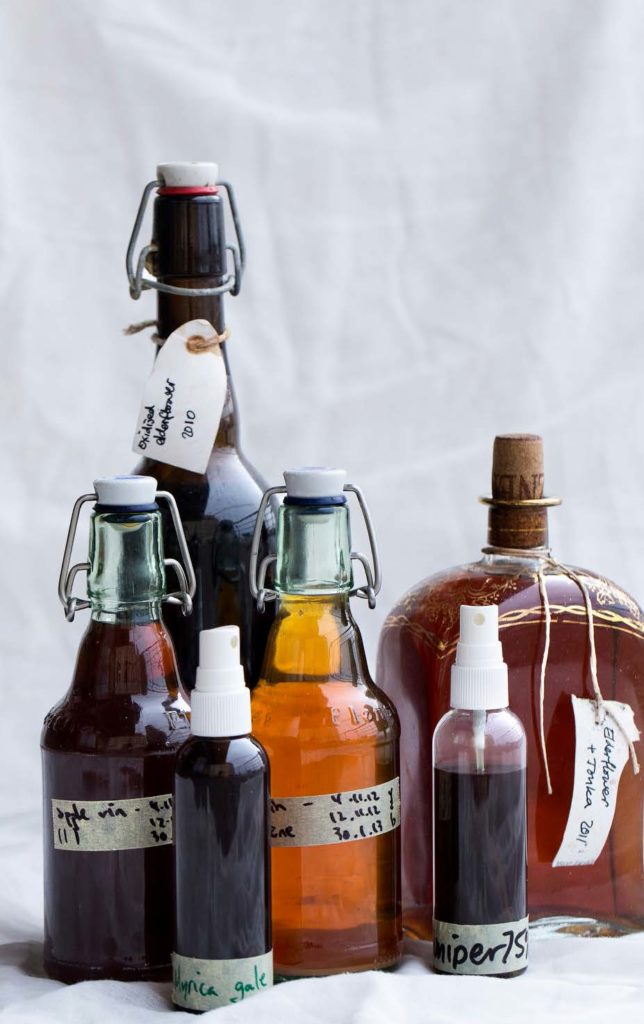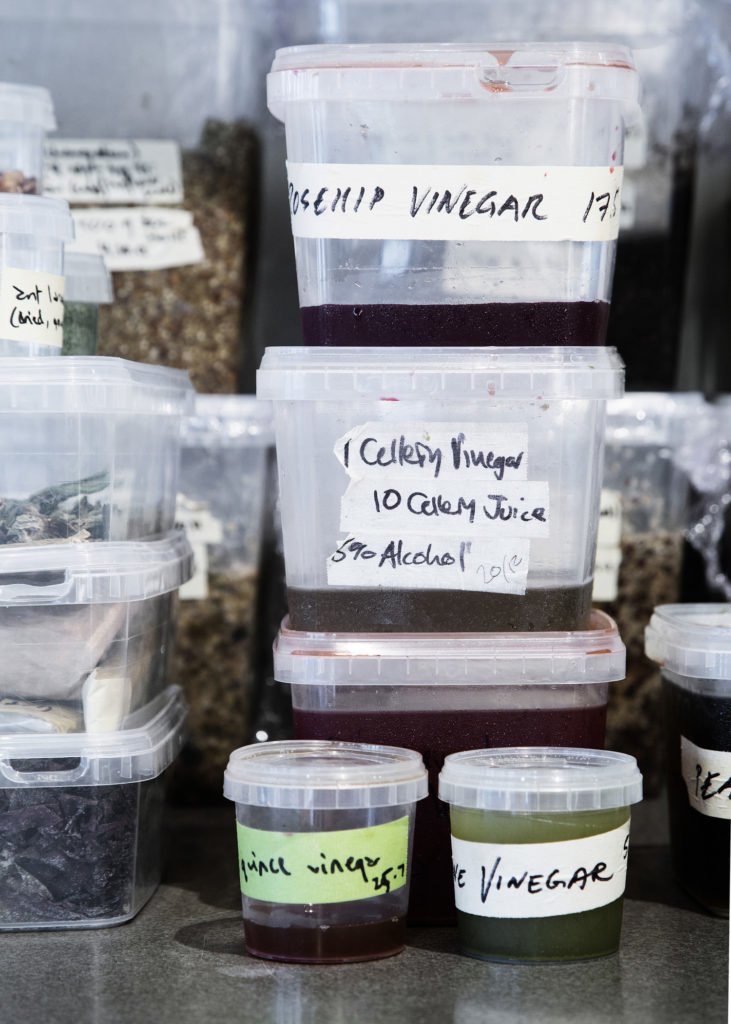by Arielle Johnson
Overview
Acetic bacteria + Alcoholic liquid + Air = Vinegar
Producing vinegar is an exploration of the ways in which raw ingredients and microbial populations interact to produce interesting, delicious, and complex flavours. In this first post of a five-post mini-series on vinegar, we give a brief overview of the fermentation process and the ways that acetic bacteria preserve, transform, and deepen flavours through manipulation on their environment. The essential components of a vinegar fermentation are a liquid that is somewhat acidic and contains ethyl alcohol (between 5 and 18% by volume), acetic bacteria, and oxygen. The mixture can be aerated passively or actively. The passive method is more traditional – all other things equal, the ratio of surface area to volume determines the rate of the fermentation. The active method involves aerating the mixture with a device like an aquarium pump, which can complete the fermentation in 4-5 days, or an industrial vinegar tank which can produce finished vinegar in a matter of hours.
This mini-series of posts, of which this is the first of five, focuses on vinegar. A reasonable first question is: “why experiment with making vinegar in the first place?”
One of our stated goals is “to explore the building blocks of Nordic cuisine, investigating old and new raw materials and techniques, developing knowledge and ideas for the Nordic region and the world.”
Some of our main explorative activities are:
Exploration of ingredients: Investigating new and old Scandinavian ingredients (Scandinavian by virtue of growing or occurring in the region, or being part of the region’s culinary memory) and their various uses – both immediate uses and uses enabled by processing.
Exploration of process: Looking into the history of fermentation, especially as historical ethnomicrobiology, and figuring out how its processes can be applied to novel ingredients.
Exploration of flavour: expanding both the lexicon and the grammar of flavours we have to work with in the kitchen. In other words, both the range of flavours we have to work with, and our understanding of how they can be put together. Borrowing the terminology of the arts this can also be though of as a palette and an aesthetic.
Making vinegar is a synthesis of these threads of exploration: as a process, it is applicable to a wide range of ingredients and transforms their flavour while retaining their essence. It also creates acidity, which, when working with local ingredients in a climate that doesn’t produce citrus fruits, is something we appreciate.
The backbone of vinegar-making is:
acetic bacteria + alcoholic liquid + air → vinegar
In the past the Nordic Food Lab has done several experiments with rapid prototyping of non-traditional vinegars. We have taken this iterative process a step further, developing vinegars then analyzing them with sensory and chemical profiling techniques. Through this method we hope to learn what, systematically, is going on when we make vinegar, how the process is best applied to the ingredients we have access to, and how to incorporate knowledge about flavour chemistry into a working, intuitive understanding of flavour – as well as more broadly to increase the working dialogue between culinary and scientific approaches to research and development.

Microbiology & Technique
At Nordic Food Lab we draw on processes from around the world that make use of microbes, especially fungi and bacteria, to transform, preserve, and deepen flavours. Each strain of microbe consumes and lives on a different food source (also called a substrate) which it metabolizes into substances like alcohol, sugar, lactic acid, and aromatic compounds, and requires specific atmospheric conditions, such as the presence or absence of oxygen, to survive.
The microbes of greatest interest for vinegar-making, acetic bacteria, consume ethyl alcohol and oxygen and produce the tart, volatile acetic acid that gives vinegar its distinct taste. These naturally abundant bacteria sometimes ferment alcoholic liquids spontaneously into vinegar without human intervention, as can sometimes happen in wineries when barrels turn ‘bad’. We can also take advantage of the bacteria’s willingness to ferment, by creating the acidic, alcoholic, aerated conditions that they will thrive in – generally by adding a portion of raw or unpasteurized vinegar as a starter to an alcoholic liquid and exposing it to oxygen – to create vinegar intentionally.
Often the creation of new foods, especially those that require fermentation, begins with looking at the microbiology of older foods – in this instance, traditional grape vinegars – and figuring out which conditions and parts of the process (like salinity, acidity, oxygenation and ratio of exposed surface area to volume) are most essential, and applying these in novel ways that may not be immediately obvious.
Practically and empirically speaking, the essential components of a vinegar fermentation are a liquid that is somewhat acidic and contains ethyl alcohol (between 5 and 18% by volume), acetic bacteria, and oxygen.
Unlike lactic fermentation (see here, here, here, and here), which occurs best in low-oxygen environments such as under brine or in a container sealed with an airlock, acetic bacteria need oxygen to do their work. We can aerate vinegar passively, by simply exposing the fermentation vessel to air, usually with a cloth of some kind over the top to keep insects out, and achieve a finished vinegar in 1 to 4 months.
Vinegar can be produced even faster if it is actively aerated. Some industrial producers accomplish this by pumping the proto-vinegar through loosely packed woodchips, which, because of their large surface area exposed to the air, facilitate full fermentation in just a few days. Other approaches use a turbine-like structure to force air through a large tank and can turn alcoholic liquids into vinegar in 20 hours or less.

